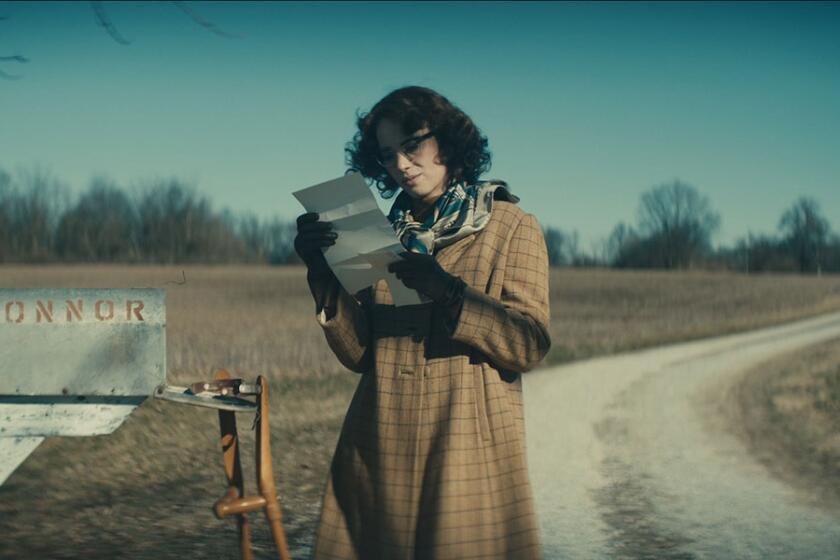UCLA Film & Television Archive Festival of Preservation returns
It’s so big it takes 24 evenings of programming spread over two months to contain all of its treasures. It’s so important it’s going to travel all across North America, visiting cities from Vancouver, Canada, to New York. And it’s such a deep-dish delight for hard-core film fans it could only have come from Los Angeles. Ladies and gentlemen, the UCLA Film & Television Archive Festival of Preservation has returned.
This is the 14th UCLA festival, at one time an annual event and now held every other year at the Hammer Museum’s Billy Wilder Theater in Westwood. Once again, it has something for everyone, as the archive first restores and then screens a wide range of cinema -- it’s frankly dizzying to describe it all.
If you are looking for independent classics, John Cassavetes’ “A Woman Under the Influence” opens the festival Friday night and a John Sayles double bill of “Return of the Secaucus Seven” and “The Brother From Another Planet” is scheduled for next week.
If you want landmark documentaries, Emile de Antonio’s “Point of Order” is on the schedule, as is “Word Is Out: Stories of Some of Our Lives.” Foreign-language aficionados can sample 1964’s “Gamperaliya,” the first independent film from Sri Lanka, while fans of silent comic Max Davidson (I know you’re out there) can see his newly restored “The Boy Friend” as part of a Hal Roach evening.
Should vintage television be to your taste, there’s 1970’s “Johnny Cash Presents the Everly Brothers Show,” and as for really early theatrical features, there’s “A Tale of Two Cities” -- not the one with Ronald Colman but Vitagraph’s 1911 version, one of the first three-reel dramas.
My personal favorites every festival fall into the treasures-from-the-attic category. What could be better than to sample the eclectic collection of rarities, oddities and one-offs that the festival manages to rescue from the far corners of the archive’s staggering holdings?
That “Tale of Two Cities” is not the only intriguing silent on the schedule; 1914’s “In the Land of the Head Hunters,” set among the Kwakwaka’wakw people of British Columbia and directed by photographer Edward S. Curtis, predated “Nanook of the North” by nearly a decade in having an all-indigenous-peoples cast. And Josef von Sternberg’s moody, heavily romanticized look at lower-class life, 1925’s atmospheric “The Salvation Hunters,” is considered by the archive to be “possibly Hollywood’s first ‘independent’ production.”
Early sound films are also well-represented. “Pointed Heels,” starring William Powell and Fay Wray, is most celebrated for a rare appearance by Helen “Sugar” Kane, a live-wire 1920s entertainer whose “boop-boop-a-doop” singing style made her the unmistakable real-life model for the very animated Betty Boop.
Equally musical are a selection from the archive’s peerless collection of sound-on-disc Vitaphone shorts. Hear Helen Morgan, the queen of been-around voices, and watch in awe as the Mound City Blue Blowers demonstrate a mastery of that most unlikely of musical instruments -- the suitcase.
The early sound films with the most emotional resonance are, not surprisingly, a double bill of features directed by Frank Borzage, who fearlessly pushed the envelope in terms of unabashed sentiment, the way today’s directors push it in terms of violence and gore.
First on the bill is 1932’s “Young America,” which, its stirring title notwithstanding, is an intimate drama of the transformative yet completely chaste friendship two young teenage boys have for each other. They really don’t make them like this anymore.
Borzage’s “Song O’ My Heart” from 1930 has the additional advantage of starring the legendary Irish tenor John McCormack in the story of (what else) a legendary Irish tenor with romantic problems. If McCormack singing “The Rose of Tralee” doesn’t put you away, his “Little Boy Blue” certainly will.
At the other end of the spectrum are the dark noirs that dot the UCLA program like black pearls. Looking especially crisp in their newly restored prints are “Ruthless,” B-picture impresario Edgar G. Ulmer’s version of “Citizen Kane,” and the Joan Bennett-starring “Secret Beyond the Door,” directed by Fritz Lang with an assist from the superb cinematography of Stanley Cortez and a Miklos Rozsa score.
Paired as a double bill are two forgotten gems from 1951. Joseph Losey’s “The Prowler” stars Evelyn Keyes as a lonely wife and Van Heflin as the bitter cop who only adds to her troubles. This film flabbergasted the critic from Variety, who called it “a bawdy, daring story that must be restricted to the adult market.” I think he meant that as a compliment.
On the same program is Max Nossek’s “The Hoodlum,” starring perennial bad guy Lawrence Tierney as, not to put too fine a point to it, a complete thug.
When these films opened as a double bill in Los Angeles, Times critic Philip K. Scheuer wrote, “The titles are short and sweet these days. They are the only things about these pictures that are.”
Though I’ve seen only parts of it, the most boggling program of the entire series looks to be “Behind the Scenes in Hollywood,” which samples the archive’s fascinating collection of cinematic flotsam and jetsam.
Here are Eva Marie Saint and Alfred Hitchcock promoting “North by Northwest” in Chicago. Here is possibly the first-ever 1942 screen appearance by Robert Mitchum, as a nameless extra getting hair put on his chest in a Max Factor promotional film called “The Magic of Make-Up.”
And perhaps most magical of all, here is newsreel footage of the pack-animal convoy used to transport the crew of the lost Erich von Stroheim epic, “Greed,” to Death Valley, as well as shots of a scene being filmed, complete with off-screen piano and violin.
Those were the days.
--
--
(BEGIN TEXT OF INFOBOX)
Festival of Preservation
Where: Billy Wilder Theater at the Hammer Museum, 10899 Wilshire Blvd., Westwood
When: Friday through April 26
Price: $10
Info: (310) 206-8013 or www.cinema.ucla.edu
SCHEDULE
All screenings at 7:30 p.m. except as noted.
Friday: “A Woman Under the Influence”
Saturday: “The Salvation Hunters”
Sunday at 7 p.m.: “Young America,” “Song O’ My Heart”
Wednesday: “The Film Parade & Vitagraph Treasures” (including “A Tale of Two Cities”)
March 20: “The Prowler,” “The Hoodlum”
March 21: “The Brother From Another Planet,” “Return of the Secaucus Seven”
March 22 at 7 p.m.: “A Hal Roach Silent Sampler”
March 26: “The Naked Eye”
March 28: “Parting Glances”
March 29 at 7 p.m.: “Silent and Early Sound Films From the Hearst Metrotone News Collection”
April 1: “Johnny Cash Presents the Everly Brothers Show”
April 3: “Point of Order!”
April 4: “Secret Beyond the Door”
April 5 at 7 p.m.: “Lena Rivers,” “He Fell in Love With His Wife”
April 6: “Check and Double Check,” “Pointed Heels”
April 10: “Behind the Scenes in Hollywood”
April 11: “Women of All Nations,” “Not Exactly Gentlemen”
April 15: “Run, Tecato, Run”
April 17: “Gamperaliya”
April 18: “Ruthless”
April 19 at 2 p.m.: “The Buccaneer”
April 19 at 7 p.m.: “Legacies From the One Archives”
April 24: “Word Is Out: Stories of Some of Our Lives”
April 25: “Vitaphone Varieties 1927-1931”
April 26 at 7 p.m.: “In the Land of the Head Hunters”
More to Read
Only good movies
Get the Indie Focus newsletter, Mark Olsen's weekly guide to the world of cinema.
You may occasionally receive promotional content from the Los Angeles Times.







